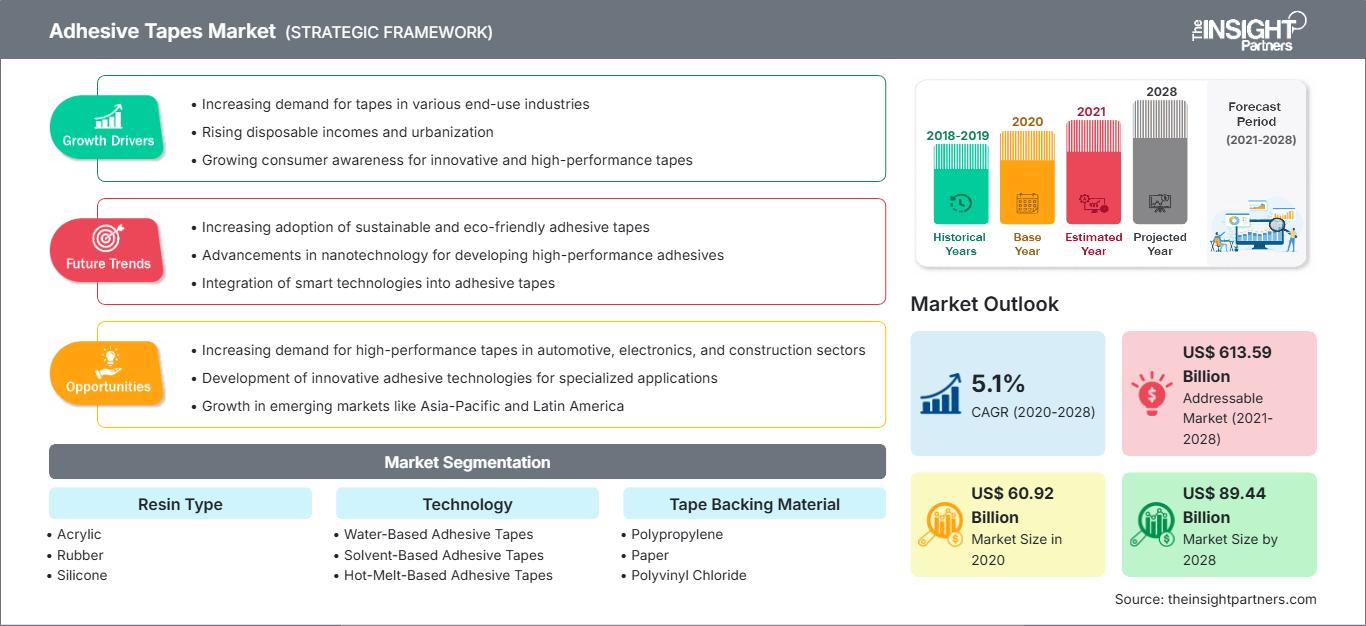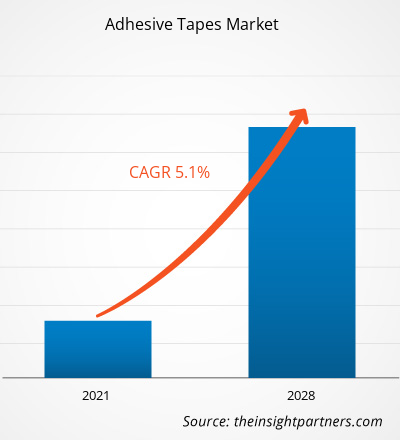2020 年胶带市场价值为 609.2261 亿美元,预计到 2028 年将达到 894.4092 亿美元;预计 2021 年至 2028 年的复合年增长率为 5.1%。
胶带有两种类型:
特种胶带和普通胶带。胶带采用的涂层技术包括水基、溶剂基和热熔胶。技术进步导致
近年来对轻质背衬材料的需求不断增长。胶带广泛应用于包装、汽车和医疗保健行业。
2020 年,亚太地区占据全球胶带市场的最大份额。预计在预测期内,亚太地区的复合年增长率也将最高。由于人口基数庞大、可支配收入增加以及生活水平提高等诸多因素,预计该地区对胶带的需求将持续增长。汽车市场的增长也推动了亚太地区对胶带的需求。这些因素也吸引了外国企业在该地区拓展业务。此外,亚太地区的快速增长也归功于该地区建筑业的增长。中国是全球最大的建筑市场,预计未来几年将大幅增长。此外,印度等其他经济体也将以惊人的速度增长,重点是促进国内制造业活动。
新冠疫情对全球胶带市场的影响喜忧参半。汽车、建筑、电子和电气等多个行业都经历了急剧下滑。相比之下,由于对个人防护装备和医疗设备的需求过大,自疫情爆发以来,医疗保健行业却实现了增长。随着经济复苏,许多行业和经济体正在战略性地规划对医疗保健领域的投资。预计这将推动胶带市场的增长。卫生相关举措包括采购专业医疗和个人防护设备 (PPE)、提升研发能力、增聘员工并增加福利、支持医院和地方政府以及捐赠疫苗生产。此外,3M 公司、Tesa SE 和日东电工株式会社等许多公司已开始积极推广该产品,以扩大客户群并减少业务影响。
自定义此报告以满足您的要求
您将免费获得任何报告的定制,包括本报告的部分内容,或国家级分析、Excel 数据包,以及为初创企业和大学提供超值优惠和折扣
胶带市场: 战略洞察

- 获取本报告的主要市场趋势。这个免费样本将包括数据分析,从市场趋势到估计和预测。
市场洞察:胶带的广泛应用
您将免费获得任何报告的定制,包括本报告的部分内容,或国家级分析、Excel 数据包,以及为初创企业和大学提供超值优惠和折扣
胶带市场: 战略洞察

- 获取本报告的主要市场趋势。这个免费样本将包括数据分析,从市场趋势到估计和预测。
胶带是由材料和胶膜组合而成,用于粘合或连接物体,取代使用螺钉、紧固件或焊接。胶带无需紧固件或螺钉即可保护表面,因此适用于包装、医疗保健、汽车、电气和电子以及建筑和施工等行业的各种应用。液体粘合剂麻烦且耗时,因为必须在粘合前喷涂或滚涂在表面上。胶带主要应用于包装、医疗保健、汽车、电气和电子以及建筑和施工等行业。
应用洞察
根据应用,全球胶带市场细分为包装、医疗保健、汽车、电气和电子、建筑和施工等。汽车领域在 2020 年引领了市场。胶带在汽车领域有多种应用。在汽车内饰中,胶带用于座椅加热元件、安全气囊的包裹和固定、方向盘的包裹、橡胶支架、塑料型材以及仪表板上的泡沫和织物固定。在汽车内饰中,例如用于移动设备、电子充电器、空气净化器、便携式冰箱的连接以及其他部件的连接,胶带也用于紧固和粘合。此外,它们还用于开发汽车电子设备,例如车灯组件、空调系统、电子显示面板、电池连接器和电线以及传感器。此外,胶带正在迅速取代螺母螺栓紧固件,以减轻车辆重量并提升车辆美观度。预计未来几年对车辆轻量化密封的需求不断增长以及电动汽车制造中胶带使用量的增加将促进胶带市场的增长。
胶带市场的一些主要市场参与者包括 3M、Nitto Denko Corporation、tesa SE、Avery Dennison Corporation、Intertape Polymer Group、LINTEC Corporation、Berry Global Inc、Scapa、Lohmann GmbH 和
报告重点:
报告重点:
- 全球胶带市场不断发展的行业趋势,帮助参与者制定有效的长期战略
- 发达市场和发展中市场采用的业务增长战略
- 2019 年至 2028 年全球胶带市场的定量分析
- 各行业对胶带的需求估计
- PEST 分析,说明行业买家和供应商预测市场增长的有效性
- 了解竞争激烈的市场格局和对胶带的需求的最新发展
- 市场趋势和前景,以及推动和抑制胶带市场增长的因素
- 通过了解支撑全球胶带市场增长的商业利益的策略来进行决策
- 不同市场节点的胶带市场规模
- 全球胶带市场的详细概述和细分
- 各地区胶带市场规模及增长机遇
本报告将全球胶带市场细分如下:
- 按树脂类型,胶带市场分为丙烯酸、橡胶、硅胶等。
- 按技术,胶带市场分为水基胶带、溶剂型胶带和热熔型胶带。
- 按胶带基材,胶带市场分为聚丙烯 (PP)、纸、聚氯乙烯 (PVC) 等。
- 按应用,胶带市场分为包装、医疗保健、汽车、电气和电子、建筑和施工等。
胶带市场
The Insight Partners 的分析师已详尽阐述了预测期内影响胶带市场的区域趋势和因素。本节还讨论了北美、欧洲、亚太地区、中东和非洲以及南美和中美洲的胶带市场细分和地域分布。
胶带市场报告范围
| 报告属性 | 细节 |
|---|---|
| 市场规模 2020 | US$ 60.92 Billion |
| 市场规模 2028 | US$ 89.44 Billion |
| 全球复合年增长率 (2020 - 2028) | 5.1% |
| 历史数据 | 2018-2019 |
| 预测期 | 2021-2028 |
| 涵盖的领域 |
By 树脂类型
|
| 覆盖地区和国家 | 北美
|
| 市场领导者和主要公司简介 |
|
胶带市场参与者密度:了解其对业务动态的影响
由于消费者偏好的不断变化、技术进步以及对产品优势的认知度不断提高等因素,终端用户需求不断增长,推动了胶带市场快速增长。随着需求的增长,企业不断扩展产品线,不断创新以满足消费者需求,并抓住新兴趋势,从而进一步推动市场增长。

- 获取 胶带市场 主要参与者概述
- 3M
- Nitto Denko Corporation
- tesa SE
- Avery Dennison Corporation
- Intertape Polymer Group
- LINTEC Corporation
- Berry Global Inc
- Scapa
- Lohmann GmbH & Co.KG
- Rogers Corporation
- 历史分析(2 年)、基准年、预测(7 年)及复合年增长率
- PEST和SWOT分析
- 市场规模、价值/数量 - 全球、区域、国家
- 行业和竞争格局
- Excel 数据集
近期报告
相关报告
客户评价
购买理由
- 明智的决策
- 了解市场动态
- 竞争分析
- 客户洞察
- 市场预测
- 风险规避
- 战略规划
- 投资论证
- 识别新兴市场
- 优化营销策略
- 提升运营效率
- 顺应监管趋势




















 获取免费样品 - 胶带市场
获取免费样品 - 胶带市场